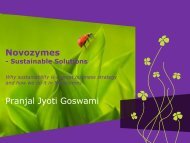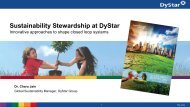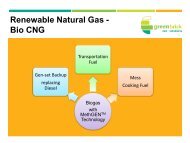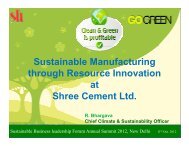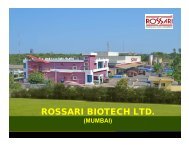Dr. Kannan Muthu , Global Sustainability Consultant, SGS
Dr. Kannan Muthu , Global Sustainability Consultant, SGS
Dr. Kannan Muthu , Global Sustainability Consultant, SGS
Create successful ePaper yourself
Turn your PDF publications into a flip-book with our unique Google optimized e-Paper software.
CONTINUOUS IMPROVEMENT<br />
Low Carbon and Energy Efficient Products -<br />
Carbon Calculation & Labeling of Products<br />
<strong>Dr</strong>. <strong>Kannan</strong> <strong>Muthu</strong>,<br />
Eco-design <strong>Consultant</strong>,<br />
<strong>Global</strong> <strong>Sustainability</strong> Services,<br />
<strong>SGS</strong> Hong Kong Limited<br />
New Delhi-11 th Ocotober 2012<br />
Version 1.0
AGENDA<br />
Introduction<br />
Item<br />
Market Trends<br />
Product Carbon footprint<br />
Case studies
DEDICATED SUSTAINABILITY<br />
SOLUTIONS FOR CONSUMER GOODS<br />
<strong>SGS</strong> CTS <strong>Sustainability</strong> Services<br />
Social<br />
Responsibility<br />
REACH<br />
Restricted substances management<br />
<br />
<br />
<br />
Social Audits<br />
Bribery prevention<br />
Anti-corruption Audits<br />
Ecodesign<br />
<br />
<br />
<br />
<br />
SVHC testing<br />
REACH only representative<br />
SIEF and Third party<br />
representation<br />
Safety data sheet<br />
Analyse<br />
Design<br />
Promote
<strong>SGS</strong>’s ECO-DESIGN SERVICES<br />
Analyse<br />
Design<br />
Promote<br />
•Benchmarks<br />
•Market analysis<br />
•Diagnostics<br />
•Screening LCA<br />
•Full LCA<br />
•Carbon Footprint<br />
•Eco-design consultancy<br />
•Training<br />
•Comparative LCA<br />
•Creativity workshops<br />
•Packaging improvement<br />
•Responsible purchasing<br />
/procurement<br />
•Communication strategy<br />
•Green claims Validation<br />
•Environmental Product<br />
declarations<br />
•Environmental Labelling<br />
•Product Carbon Footprint<br />
Marks
TRENDS AND NEEDS<br />
• Consumers are increasingly concerned by the<br />
environmental impact of the product they buy<br />
• Consumers / stakeholders demand more transparency and<br />
information on products:<br />
• According to a 2010 survey performed on the French market, 74% of<br />
consumers* - 66% in 2011- said they want to see environmental impact<br />
information on the products they buy.<br />
• 51% of consumers declare not to buy a product from companies whom they<br />
disapprove of their behavior and prefer to buy products in line with their own<br />
convictions.<br />
• Carbon footprint is one of the most widely known and<br />
recognised environmental impacts<br />
* Ethicity 2010 & 2011, yearly survey on French market
CARBON FOOTPRINT : A MARKETING TOOL<br />
• Adding a carbon footprint on a product provides consumers with<br />
the simple selection criteria they are looking for<br />
• Brands and Retailers are increasingly using the environmental<br />
impact of the product as a marketing tool.
GREEN IS A MAINSTREAM<br />
• 76% of consumers purchase some green products currently<br />
• 8% of consumers buy green products as their purchases majority<br />
• 1% of consumers stop buying after the purchase of green products<br />
at one point<br />
• Almost all consumers who buy green expect to remain green, while<br />
those who don't buy certain product categories of green products<br />
intend to do so in the future<br />
Purchase Behavior<br />
Age<br />
Source: A survey of 520 US green consumers who are aware of green products and who have purchased green products in the past, Grail Research, LLC
PRODUCT ENVIRONMENTAL ASSESSMENT-CO2 LABELLING<br />
• In 2007, Casino France collected the environmental data concerning 220<br />
products with the supplier’s participation.<br />
• CO2 labelling will be implemented on 3000 product approximately.<br />
Explanation of Casino group concerning its<br />
initiative of CO2 labelling<br />
A little ruler to know the environmental<br />
impact level of the Product.<br />
Source: www.groupe-casino.fr
JAPAN<br />
carbon footprint labelling on food packaging and other<br />
products in an ambitious scheme to persuade<br />
companies and consumers to do more to reduce their<br />
GHG emissions.<br />
The labels will appear on food, drink, detergents and<br />
electrical appliances
PRODUCT CARBON FOOTPRINT
KOREA CARBON FOOTPRINT LABEL<br />
Selection of 10<br />
target products<br />
for Pilot<br />
Carbon label<br />
project<br />
beginning from<br />
2008
UNITED STATES: CARBON FREE LABEL<br />
The Carbon Fund, an independent nonprofit<br />
carbon offset provider, developed the<br />
‘Certified CarbonFree’ label along with<br />
Edinburgh Center for Carbon Management<br />
This label is based on ISO lifecycle analysis<br />
standards, the GHG protocol and the<br />
UK Carbon Trust’s (2007) Methodology<br />
Range covers certain products of drinks<br />
manufacturer, organic sugar company & also<br />
cellphone company
GERMAN 1 ST PROJECT OF PCF<br />
In the first project of its kind in Germany, ten<br />
businesses came together in 2008 to start<br />
measuring the life cycle emissions of CO2 and<br />
other greenhouse gases related to selected<br />
products and services - the Product Carbon<br />
Footprint
CARBON LABELS IN SWITZERLAND<br />
The test results are independently checked.<br />
To be a CO 2 Champion, a product must emit<br />
around 20 less CO 2 . Migros introduced the<br />
label in 2008. Now more than 100 products<br />
carry the logo<br />
Switzerland’s top supermarket chain,<br />
Migros, last year embarked on a product<br />
carbon labelling programme. Consumers<br />
can now find seven Migros own-brand<br />
products carrying the Climatop carbon<br />
label.
PRODUCT CARBON FOOTPRINT<br />
Thailand<br />
<strong>SGS</strong><br />
Korea<br />
Germany<br />
Taiwan<br />
UK<br />
Japan<br />
France<br />
PRODUCT CARBON FOOTPRINT<br />
• <strong>SGS</strong> <strong>Sustainability</strong> Services can provide assistance with all steps up of implementation for partial or<br />
full life cycle including calculation using specialist databases<br />
• Data collection includes primary data collected from suppliers and secondary data from life<br />
cycle databases / literature researches
ECODESIGN IN PRODUCT AND PACKAGING<br />
A holistic environmental approach – Life Cycle Thinking
ECO-DESIGN<br />
• Eco-design is a crucial factor to<br />
minimize the environmental<br />
impact of products. As a<br />
preventive approach, ecodesign<br />
will determine the processes,<br />
materials and energy required to<br />
produce a product, its<br />
functionalities and its destination<br />
at the end of its life cycle is<br />
determined during the design<br />
stage.<br />
• Ecodesign plays a key role in<br />
reaching sustainability goals.
LIFE CYCLE APPROACH<br />
Quantify environmental<br />
impacts throughout the<br />
product life cycle…<br />
量 化 产 品 生 命 周<br />
期 的 环 境 影 响
PRODUCT ENVIRONMENTAL ASSESSMENT- LIFE CYCLE<br />
ASSESSMENT<br />
Life Cycle Assessment (LCA) - compilation and evaluation of the inputs, outputs and the<br />
potential environmental impacts of a product system throughout its life cycle. <br />
• Inputs, outputs : Material, Energy, Waste, Emissions, Product<br />
• Environmental impacts : <strong>Global</strong> warming, Ozone depletion, Acidification…)<br />
• Life cycle : Raw materials, Production, Transport, use, end of life. )
<strong>SGS</strong> CARBON FOOTPRINT MARKS
CONTINUOUS IMPROVEMENT<br />
EFFECTIVE DRIVERS FOR CONTINUOUS<br />
IMPROVEMENT...<br />
Attests that a robust calculation of the total greenhouse gas emissions of a product<br />
has been performed over its life cycle<br />
TRANSPARENCY<br />
Customer can:<br />
•Start communicating directly on product<br />
•Set up a carbon reduction strategy<br />
•Identify reduction and cost saving opportunities<br />
•Define a target<br />
Attests that the Carbon Footprint of a product has been reduced in a continuous<br />
improvement scheme from the initial Carbon Footprint Calculation<br />
REDUCTION ACHIEVEMENT<br />
Customer can:<br />
•Assess progress<br />
•Act for the environment<br />
Attests that once significant reductions in GHG emissions of the product have taken<br />
place, any residual emissions have been compensated through recognised external<br />
credits schemes<br />
OFFSET<br />
21
<strong>SGS</strong> CARBON FOOTPRINT MARKS<br />
• A mark that can be applied on any products<br />
• A label that shows how and when the calculation<br />
was done.<br />
Greenhouse gas<br />
emissions of this 1kg<br />
of chicken meat are<br />
3.5kg CO2 eq. The<br />
calculation is based on<br />
the data collected in<br />
Jan 2010 from cradle<br />
to gate.<br />
• Registration and legal assessment done to use the<br />
label worldwide<br />
<strong>SGS</strong> Report<br />
No. 123456<br />
For more information:<br />
www.sustainability.sgs.com<br />
22
ADVANTAGES OF THE <strong>SGS</strong> SCHEME<br />
• First global mark in the world<br />
• Not a certification mark<br />
• No extra-cost<br />
23
PRICING<br />
• The more studies are performed, the less it costs.<br />
• Price must not be a barrier.<br />
• Part 1 – Price for footprint CALCULATION<br />
• The main cost comes from the initial carbon calculation. The average<br />
cost per product decreases as the number of products per category<br />
increases.<br />
• Quoted in man-days<br />
• Part 2 – Price for LICENSE FEES<br />
• The more products that <strong>SGS</strong> assesses the carbon footprint, the<br />
cost of the mark reduces on a sliding scale<br />
• Our license fees only cover the cost of use, registration and<br />
assessment of the mark.<br />
24
A CONCEPT THAT RESONATES<br />
CARBON<br />
FOOTPRINT<br />
shows<br />
your<br />
product’s<br />
Environmental<br />
impact<br />
Also leads to<br />
opportunities on<br />
Process<br />
Raw materials<br />
Product<br />
Supply chain and transport<br />
Risk management<br />
Reputation<br />
Customer loyalty<br />
Brand image<br />
Cost<br />
25
<strong>SGS</strong> ORGANIZATION<br />
• 7 teams all around the world to ensure <strong>SGS</strong> is offering this<br />
service everywhere<br />
<strong>Sustainability</strong> teams in :<br />
- Asia : Hong-Kong, China, India and Thailand<br />
- Europe : France, Uinited Kigdom and Germany<br />
- America : United States of America.<br />
• A global <strong>Sustainability</strong> network that allows a strong<br />
collaboration with <strong>SGS</strong>’ affiliates to support (action plans<br />
definition, data collection, communication, etc…) and to<br />
deliver.<br />
26
HOW DOES IT WORK ?
THREE INTERNATIONAL PCF STANDARDS<br />
• <strong>SGS</strong> consultants calculate carbon footprints The client decides which standard<br />
he prefers to use according to the local context.<br />
• WRI GHG Protocol Scopes 1-3 and upcoming product life cycle and supply chain standards<br />
• ISO 14067 – Carbon Footprint of products<br />
• BSI PAS 2050:2008: carbon footprint of products and service<br />
• <strong>SGS</strong> consultants have access to specialist tools and software to assess your<br />
product : Simapro LCA software, Ecoinvent database..<br />
Training and<br />
awareness<br />
Project proposal and<br />
defining methodology<br />
Setting boundaries<br />
and prioritization<br />
Data collection,<br />
calculation and<br />
precision<br />
Report and<br />
validation<br />
Carbon Footprint<br />
28
WHICH LOGIC BEHIND A PROJECT ?<br />
• Our mission:<br />
• Introduce carbon footprint concept our client’s teams<br />
• Perform the carbon footprint of owned activities by collecting data from<br />
the plants<br />
• Complete the product carbon footprint thanks to scientific literature<br />
review and databases<br />
• Methodology:<br />
• GHG Protocol, ISO 14044 and IPCC 2007 Emission Factors<br />
29
DATA COLLECTION FROM SUPPLIERS<br />
• Questionnaires are used to collect relevant data from supply chain<br />
• The primary activity data are combined with emission factors and other<br />
secondary data sources to calculate the carbon footprint of the product<br />
30
PERFORM CALCULATION AND ASSESS<br />
IMPROVEMENT OPPORTUNITIES<br />
• Results chart : GHG emissions of product (e.g. Chicken meat)<br />
• Example summary conclusions<br />
<br />
<br />
Feed production: Change the recipe and choose other cereal types to decrease the<br />
carbon footprint<br />
Improvement of the direct farm emission by a specific waste management<br />
31
DELIVERABLE<br />
DRAFT 2009<br />
CARBON FOOTPRINT LIFE CYCLE<br />
ASSESSMENT FOR PRODUCT<br />
March 2012<br />
Version 1<br />
COMPANY NAME<br />
PRODUCT<br />
FINAL REPORT:<br />
• Description of product<br />
• Raw material, production processes,…<br />
• Methodology<br />
• Scope of the study<br />
• Functional unit, system boundaries, key assumptions<br />
• Methodology<br />
• Inventory analysis<br />
• Data collection and validation, allocation principles<br />
• Impact assessment and interpretation<br />
• Results<br />
ACTION PLAN:<br />
• <strong>SGS</strong> teams support to build a reduction Action plan.<br />
CARBON FOOTPRINT MARK:<br />
• <strong>SGS</strong> deliver the material to communicate (marks)<br />
and the rules associated, publish on it website the<br />
traceability of what as been calculated.<br />
32
<strong>SGS</strong> CASE STUDIES
CARBON FOOTPRINT - FOOD PRODUCTS<br />
Company’s Background<br />
A producer and distributor of tropical fruits products (pureed banana, dried<br />
bananas etc) based in the UK<br />
Project<br />
Carbon footprint of dried and pureed tropical fruit<br />
Client’s Objectives<br />
• To show their customers that they are an environmentally conscious supplier<br />
• To formulate a carbon footprint reduction plan<br />
Challenges<br />
• Different locations had to be considered in the study:<br />
• Manufacturing processing plant in Ecuador<br />
• Client in the UK<br />
• One supplier in Ecuador<br />
• Wanted a PAS2050 compliance therefore we needed to collect primary data<br />
Feedback from client:<br />
They were happy that we could<br />
communicate in English and Spanish so<br />
they could rely on <strong>SGS</strong> to lead<br />
communication with their local farmers<br />
How did we make this project successful?<br />
• By working internationally within <strong>SGS</strong>:<br />
• Involving team members in UK, Ecuador, France<br />
• Local environmental auditors in Ecuador<br />
• LCA expert (Spanish speaking) and UK PAS2050 experts<br />
34
CARBON FOOTPRINT - FOOD PRODUCTS<br />
Company’s Background<br />
A producer of mineral water, soft drinks and beer in Germany. Focused in<br />
producing organic beverages.<br />
Project<br />
Product Carbon footprint of mineral water (with & w/o gas)<br />
Carbon Footprint of filling line<br />
Client’s Objectives<br />
• Wanted to implement organic mineral water into their portfolio<br />
• Wanted to analyse different delivery scenarios as well as different packaging<br />
scenarios (glass bottle vs. PET)<br />
Challenges<br />
• Difficulty to get primary data from bottle manufacturing plant<br />
Did this project lead to other projects with this client ?<br />
• Yes, client is interested in Carbon Footprint of glass bottle production<br />
35
CARBON FOOTPRINT - FOOD PRODUCTS<br />
Company’s Background<br />
A leading German producer and distributor of meat (pork, veal, beef)<br />
Project<br />
Critical review of Product Carbon Footprint and other environmental indicators of<br />
beef study<br />
Client’s Objectives<br />
• Client is working on carbon footprinting the past three years (pork, veal) and<br />
wanted to finish the first series of evaluation of their products<br />
Challenges<br />
• Short timing<br />
How did we make this project successful?<br />
• Good preparation was already existing from past critical reviews<br />
• Good communication with assessor<br />
Feedback from client:<br />
• Interested to put the Carbon footprint<br />
mark based on these verifications<br />
• Might be interested in carbon footprint<br />
calculation of next series through <strong>SGS</strong><br />
36
CARBON FOOTPRINT AND LCA – PENS<br />
Company’s Background<br />
The European subsidiary of a major writing instrument manufacturer (Japan HQ)<br />
Project<br />
• Calculation of the Corporate Carbon Footprint of their European operations<br />
• Detailed LCA of in-house processes<br />
• Screening LCA + Eco-calculator for a full product range<br />
• Brainstorm on a reduction action plan<br />
Client’s Objectives<br />
• To get prepared for the French Environmental Labelling scheme<br />
• To verify and formalise their « green » line of products<br />
• To find new ways to reduce their corporate environmental footprint<br />
Challenges<br />
• Difficulty to get some of the data:<br />
• Because HQ in Japan<br />
• Because of some process /machines<br />
How did we make this project successful?<br />
• Good communication – good project management and follow-up<br />
• Training of client internal teams including internal project team<br />
Feedback from client:<br />
Thanks to our tailor-made tool, the<br />
Client’s design team is now able to<br />
perform its own Life Cycle Analysis<br />
enabling them to choose the best way<br />
to design a product upstream.<br />
This project was followed by the<br />
development of key environmental<br />
indicators and PCF of accessories.<br />
37
CARBON FOOTPRINT - EVENTS<br />
Company’s Background<br />
An exhibition group in Germany is organizing a trade fair for sports and sports<br />
textiles<br />
Project<br />
Carbon footprint of a specific event within the trade fair<br />
Client’s Objectives<br />
• The client is seeking for ecological improvement of the location. Several<br />
installations were already implemented<br />
• The client wants to initiate a pilot study on carbon footprint to identify main hot<br />
spots in CO 2 emissions<br />
Challenges<br />
• Various parties were involved in the organisation<br />
• Collecting of primary data from different parties and participants<br />
• Data accuracy and data quality<br />
Feedback from client:<br />
• Project might be enlarged for whole<br />
exhibition<br />
• Might be also applicable for exhibition<br />
in China<br />
38
CARBON FOORPRINT TO SELECT GREEN<br />
PRODUCT LINES<br />
Company’s Background<br />
A Leading European Buying Company<br />
Project<br />
Product Carbon Footprinting<br />
Client’s Objectives<br />
• They wanted to develop a green product line<br />
• Internal education to understand their products’ environmental aspects<br />
Challenges<br />
• The range of products was wide and diverse (toys, garden tools, kitchenware<br />
and furniture):<br />
How did we make this project successful?<br />
• Support from technical teams of different product business units, R&D and<br />
<strong>Sustainability</strong> Team<br />
• Strengthen our teams’ knowledge in a wide range of products<br />
Feedback from client:<br />
Satisfied with the deliverable which they<br />
qualified as a very practical guidelines<br />
and useful information<br />
Did this project lead to other<br />
projects with this client?<br />
Yes: Environmental Audit (GSCP) &<br />
other testing/audit programs<br />
39
Product Carbon Footprint - biobased material<br />
Company’s Background<br />
An environmental technology company in China<br />
Project<br />
Development of a new Bio-based material<br />
Client’s Objectives<br />
•To calculate the Carbon Footprint of this Bio-based material<br />
•To compare the Carbon Footprint of the material with the Carbon footprint of a<br />
similar material from a foreign company<br />
•To provide internal reference<br />
•To demonstrate to their clients the carbon footprint of the material<br />
Challenges<br />
•Before contacting <strong>SGS</strong>, the client had accessed a PCF report from a foreign<br />
manufacturer. With this study, the client expected to get similar conclusions and<br />
show that their material had a lower carbon footprint than traditional plastic<br />
materials.<br />
•Some process and material data were confidential, so assumption was needed.<br />
Feedback from client:<br />
Client was satisfied with our explanation of<br />
the foreign manufacturer’s PCF<br />
report and with our calculations and<br />
the report we produced<br />
How did we make this project successful?<br />
•Good cooperation and understanding between client and <strong>SGS</strong><br />
•Researched the foreign manufacturer’s PCF report deeply<br />
•Found the energy reduction areas which can help the client to decrease its<br />
product footprint<br />
40
Product Carbon Footprint – bathroom equipments<br />
Company’s Background<br />
A leading non-metallic mining & new material manufactory in China<br />
Project<br />
Development of Bathroom products made from new material and treatment<br />
Client’s Objectives<br />
• To know the carbon footprint of bathroom products made from new material<br />
• To provide internal reference for low carbon product development<br />
• To show their client and local government that their product is environmental<br />
friendly<br />
Challenges<br />
•The government showed interest in these new bathroom equipment made from<br />
non-traditional materials.<br />
•Client wanted to get the calculation report within one month of the project kick-off.<br />
•The report had to be checked by a University professor.<br />
•The products were still under testing<br />
Feedback from client:<br />
•Client was very satisfied with the report<br />
both on the delivery time and in terms of<br />
the results.<br />
•Client communicated the positive news<br />
through their channels.<br />
How did we make this project successful?<br />
•Kept good communication with the client, ensured the data collection was<br />
efficient.<br />
•Researched the PCR of metal products and the energy consumption of ceramic<br />
products to use as benchmark and reference.<br />
41
Product Carbon Footprint - textile<br />
Company’s Background<br />
A leading textile company focusing on the textile Print and Dye in China<br />
Project<br />
Carbon footprint of satin drill<br />
Client’s Objectives<br />
To effectively manage energy consumption and GHGs emissions<br />
To build up the awareness of low carbon<br />
Challenges<br />
•Client interested in managing the energy consumption and product GHGs, but<br />
their basic awareness of PCF needed to be built up.<br />
•The challenge was in finding existing data reference.<br />
How did we make this project successful?<br />
•Started with a training session for the client project team for awareness and basic<br />
capability building<br />
•Provided technical advices during the data-collection period<br />
•Supported the client project team on the product information and data collection<br />
Feedback from client:<br />
• Our client is satisfied with the<br />
training and awareness delivery in<br />
general.<br />
• Good marketing response<br />
42
Product Carbon Footprint Mark<br />
43
AND MANY OTHERS IN CHINA<br />
FOOD<br />
AGRICULTURE<br />
PRODUCT/SEAFOOD<br />
HARDGOODS<br />
CERAMIC TOILET<br />
PRODUCTS<br />
FOOD<br />
MILK POWDER<br />
HARDGOODS<br />
PAPER<br />
PACKAGING<br />
HARDGOODS<br />
TERTIARY WOODEN<br />
PACKAGING<br />
HARDGOODS<br />
BIOMASS<br />
PLASTIC<br />
E&E<br />
INDUSTRIAL<br />
ELECTRIC FANS<br />
HARDGOODS<br />
CONCRETE<br />
44
ONGOING PROJECTS<br />
TEXTILE<br />
JEANS<br />
TURKEY<br />
INDUSTRY<br />
GAS<br />
GENERATOR<br />
GERMANY<br />
HARDGOODS<br />
INDUSTRIAL PAINT<br />
INDIA<br />
45
Contacts:<br />
<strong>Dr</strong>. <strong>Kannan</strong> <strong>Muthu</strong>,<br />
Eco-design <strong>Consultant</strong>,<br />
<strong>Global</strong> <strong>Sustainability</strong> Services,<br />
<strong>SGS</strong> (HK) Limited,<br />
E-mail: <strong>Kannan</strong>.muthu@sgs.com;<br />
Ph: 852-22048364<br />
Vinod Kumar,<br />
Manager-Sales & Marketing,<br />
<strong>SGS</strong> India Limited,<br />
Gurgaon, India<br />
Tel: 98717-94647<br />
E-mail: vinod.kumar@sgs.com





